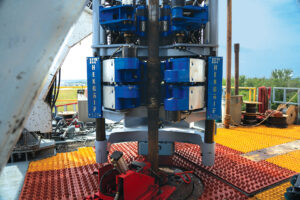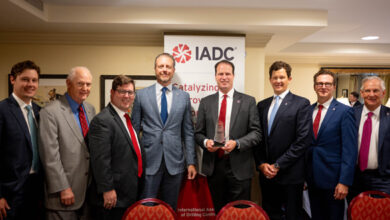Drilling & Completion Tech Digest

H&P launches new Rig Floor Automation package to enhance consistency, safety during connections
Helmerich & Payne (H&P) recently introduced Rig Floor Automation, a package that merges automation with enhanced mechanization. It consists of the HexGrip 120 automated floor wrench, Retractable Slip Lifters and traction control floor mats. Each integrated component of the package contributes to overall process execution on the rig floor.
The solution leverages interworking equipment systems to enhance operations during the fast-paced task of making and breaking tubular connections. Connection integrity is optimized by HexGrip 120, which helps prolong drill pipe life through near-concentric connection gripping, increasing makeup torque accuracy and increasing breakout torque capacity. The Retractable Slip Lifters enable seamless transition between drilling and tripping, eliminating the need to manually place and remove slips, as slips insert directly into the rig floor. For all rig floor operations, the installation of modular traction control floor mats provides integrated fluid management and color-coded hazard zone indication.
As both the HexGrip 120 wrench and Retractable Slip Lifters are safely controlled from the driller’s cabin, outside of well center, exposure reduction creates a safer workplace while directly improving jobs on the rig floor.
NASA validates AI-enabled alternating direct current as a ‘new form of energy’
NASA and ADC Energy jointly published a breakthrough validation of a “new form of energy.” The multi-year project, led by NASA Langley Research Center scientist Narasimha Prasad, evaluated and validated “alternating direct current” (ADC), an AI-enabled energy technology. The current global energy platform operates on two forms of energy – alternating current (AC) and direct current (DC). These two platforms were invented over 135 years ago by Nikola Tesla and Thomas Edison. The joint research paper with NASA validated ADC as a new “hybrid” form of energy, where both AC and DC operate on the same existing wires. This has the potential to make vintage energy conversion obsolete, the paper stated. By eliminating outdated energy conversion, ADC also presents new energy solutions.
ADC is already being deployed at lower voltages, with the near-term goal to evolve into high-voltage solutions.
Predictive Drilling boosts ROP by 36% in Delaware Basin
Nabors and Corva recently announced a strategic collaboration under which Corva’s App Store and Dev Center will be connected to Nabors’ universal rig controls and automation platforms – SmartROS and RigCLOUD.
The initial focus is to achieve cost reduction per foot of drilling by employing Predictive Drilling, an artificial intelligence/machine learning-based rate-of-penetration optimizer, while reducing dysfunctions. It enables remote control of rig site Auto Driller setpoints through a seamless cloud-to-cloud connection, without the need for any additional rig devices.
The new solution is available on all SmartROS-enabled rigs.
A Delaware Basin operator recently deployed Predictive Drilling on four wells, increasing average ROP by 36% and decreasing average vibration by 9.7%. Further, due to the ease of deployment and integration into the driller’s workflow, field utilization of Predictive Drilling increased to 80% of lateral footage drilled on the first pad.
1,000th CX-2 bridge plug deployed for North Sea P&A
Coretrax recently deployed its 1,000th CX-2 bridge plug during a project in the North Sea. The CX-2 permanent cast iron bridge plug, originally launched in 2012, is constructed of drillable materials and features a built-in setting mechanism. It is set with both hydraulic pressure and mechanical pull and has an innovative release system, with a slim outer diameter and a large inner diameter. This allows cementing operations to be completed as part of the one-trip system while minimizing cement disturbance, ultimately eliminating the need for a dedicated cementing trip. It is proven to save an average of three hours per run.




